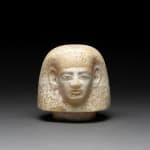Egyptian Canopic Jar Head of Imsety, 664 BCE to 525 BCE
Alabaster
height 12 cm
height 4 3/4 in
height 4 3/4 in
LA.572
Mummification was a way to honor the deceased and express a belief in the afterlife. It typically involved removing moisture from the body and using chemicals or natural preservatives, such...
Mummification was a way to honor the deceased and express a belief in the afterlife. It typically involved removing moisture from the body and using chemicals or natural preservatives, such as by removing organs except for the heart. The heart was left inside the body as it was thought to be necessary for the weighing of the soul in the afterlife. In the early days of mummification, these organs were wrapped in cloth and placed in the walls of the burial chamber. During the 4th Dynasty, canopic jars were introduced for the first time to hold the internal organs of the deceased, including the liver, lung, stomach, and intestine. These jars were meant to ensure that the organs would be preserved and available for the afterlife. Each organ was protected by one of the Four Sons of Horus: Hapy, depicted with the head of a baboon; Imsety, depicted with the head of a human; Duamutef, depicted with the head of a jackal; and Qebehsenuef, depicted with the head of a falcon. Moreover, each god was responsible for protecting a particular organ and was himself protected by a companion goddess: Hapi, representing the North, was protected by the goddess Nephthys; Duamutef, representing the East, was protected by the goddess Neith; Imsety, representing the South, was protected by the goddess Isis; and Qebehsenuef, representing the West, was protected by the goddess Serqet. From the First Intermediate Period, the heads of the Four Sons of Horus began to be engraved on the lid of the canopic jars. Therefore, the jars with human-headed lids probably held the liver and were under the protection of Imsety.



